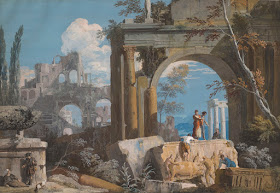 |
| Marco Ricci Landscape with a Horse being Ferried across a Stream ca. 1718-28 tempera on leather Royal Collection, Great Britain |
 |
| Marco Ricci Landscape with Two Praying Monks ca. 1728-30 tempera on leather Royal Collection, Great Britain |
 |
| Marco Ricci Wood with Figures Alarmed by a Bear ca. 1720-30 tempera on leather Royal Collection, Great Britain |
"Marco Ricci produced a large number of paintings of landscape subjects executed in the unusual technique of tempera or gouache on leather, possibly kidskin (the paint was made by binding pigments with egg yolk or gum arabic respectively). Typically measuring about 31 x 45 cm, the smooth, pale surface of skin on the stretcher gives a clarity and luminosity to the bright paint applied to it. Joseph Smith, who knew Marco Ricci well, collected 33 of Ricci's tempera paintings, all but one in the Royal Collection (acquired by George III from Consul Smith in 1762). All the works are in their original Venetian frames (some have their eighteenth-century glazing intact) and they would have hung in groups, probably on the walls of Smith's residence at Mogliano."
"Although most of Marco's temperas are not dated, they can be placed in the 1720s, his last and most productive decade. Many are pastoral scenes – mountain landscapes, villages and farms – set in the richly fertile landscape surrounding Marco's home town of Belluno in the Dolomites. Others illustrate the beauty and power of nature, with storms, torrents of water in rugged mountains, or the surprise appearance of a bear or a snake. These were all subjects that Marco had painted throughout his life, reusing the compositions of existing drawings and oil subjects in the tempera medium. In contrast to his oil paintings, in the temperas the sky is often an optimistic blue, the light refined and subtle."
"The tempera paintings demonstrate the broad range of influences that Marco absorbed. In his early years he came into contact with Alessandro Magnasco and Francesco Peruzzini of Ancona, both of whom worked close with his uncle Sebastiano Ricci. In his temperas of tempestuous weather conditions and other moments of high romance, such as figures fleeing from a bear, encountering bandits, or monks and hermits praying in isolation, Marco shows the influence of Salvator Rosa's wild and mountainous landscapes and Magnasco's dark and dramatic style."
– adapted from curator's notes at the Royal Collection
 |
| Marco Ricci Landscape with Women and Animals at a Trough ca. 1728-30 tempera on leather Royal Collection, Great Britain |
 |
| Marco Ricci Mountainside with Hermits ca. 1728-30 tempera on leather Royal Collection, Great Britain |
 |
| Marco Ricci Outskirts of a Town with Women washing Linen ca. 1720-25 tempera on leather Royal Collection, Great Britain |
 |
| Marco Ricci Rocky Landscape with a Waterfall ca. 1720 tempera on leather Royal Collection, Great Britain |
 |
| Marco Ricci Wooded Landscape with a Huntsman ca. 1720-25 tempera on leather Royal Collection, Great Britain |
 |
| Marco Ricci Woodland Scene with Bandits ca. 1724-29 tempera on leather Royal Collection, Great Britain |
 |
| Marco Ricci Landscape with Peasants and Woodcutters ca. 1723-28 tempera on leather Royal Collection, Great Britain |
 |
| Marco Ricci Town and Ruins beside a River ca. 1719 tempera on leather Royal Collection, Great Britain |
 |
| Marco Ricci Classical Ruin Capriccio ca. 1727-29 tempera on leather Royal Collection, Great Britain |
 |
| Marco Ricci Allegory with Monument to Newton 1728 tempera on leather Royal Collection, Great Britain |
 |
| Marco Ricci Ruin Capriccio with Gothic Church ca. 1720-25 tempera on leather Royal Collection, Great Britain |











































